Telehealth Technology in Managing Chronic Diabetes
VerifiedAdded on 2022/08/24
|12
|3231
|28
AI Summary
Contribute Materials
Your contribution can guide someone’s learning journey. Share your
documents today.
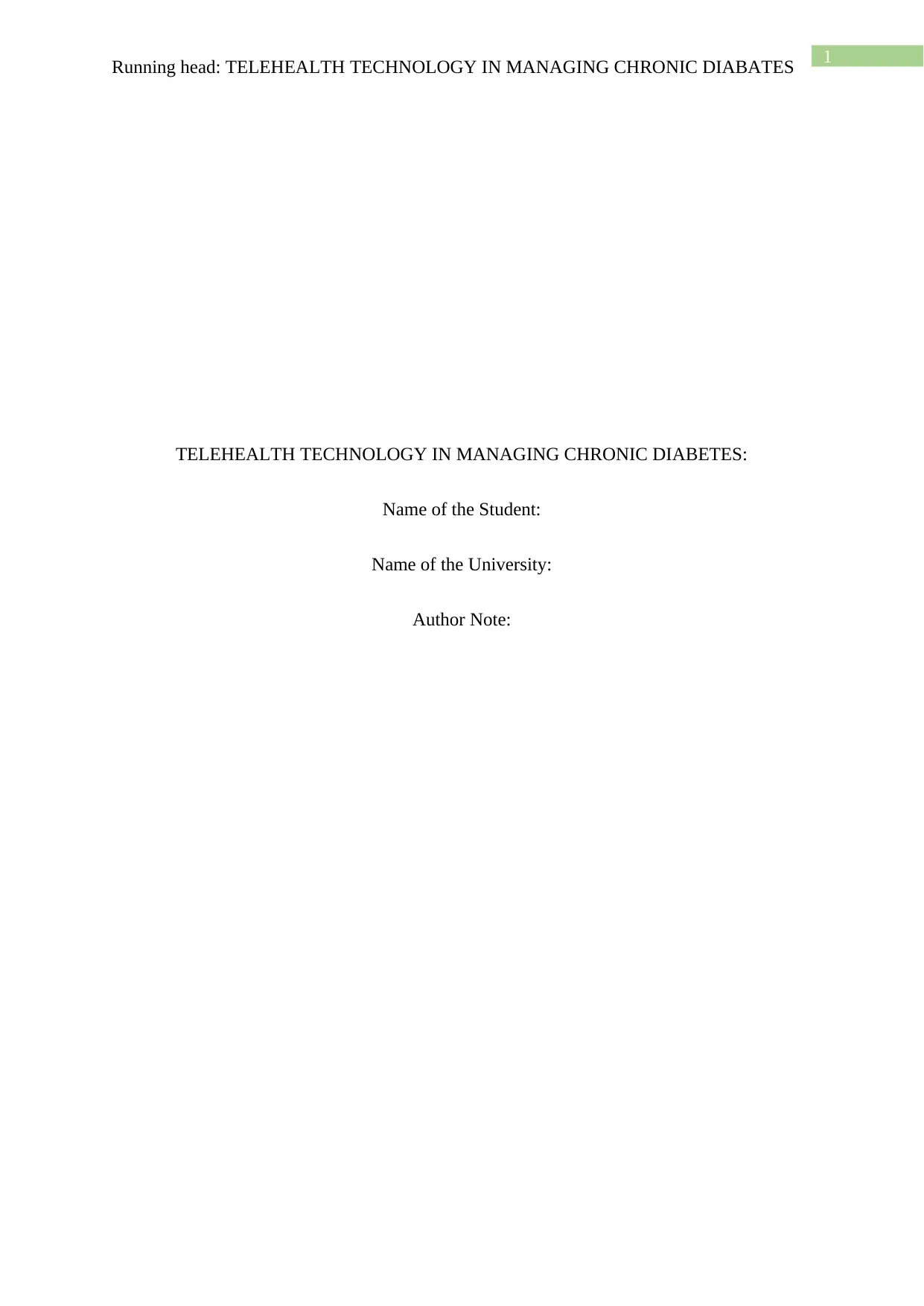
1
Running head: TELEHEALTH TECHNOLOGY IN MANAGING CHRONIC DIABATES
TELEHEALTH TECHNOLOGY IN MANAGING CHRONIC DIABETES:
Name of the Student:
Name of the University:
Author Note:
Running head: TELEHEALTH TECHNOLOGY IN MANAGING CHRONIC DIABATES
TELEHEALTH TECHNOLOGY IN MANAGING CHRONIC DIABETES:
Name of the Student:
Name of the University:
Author Note:
Secure Best Marks with AI Grader
Need help grading? Try our AI Grader for instant feedback on your assignments.
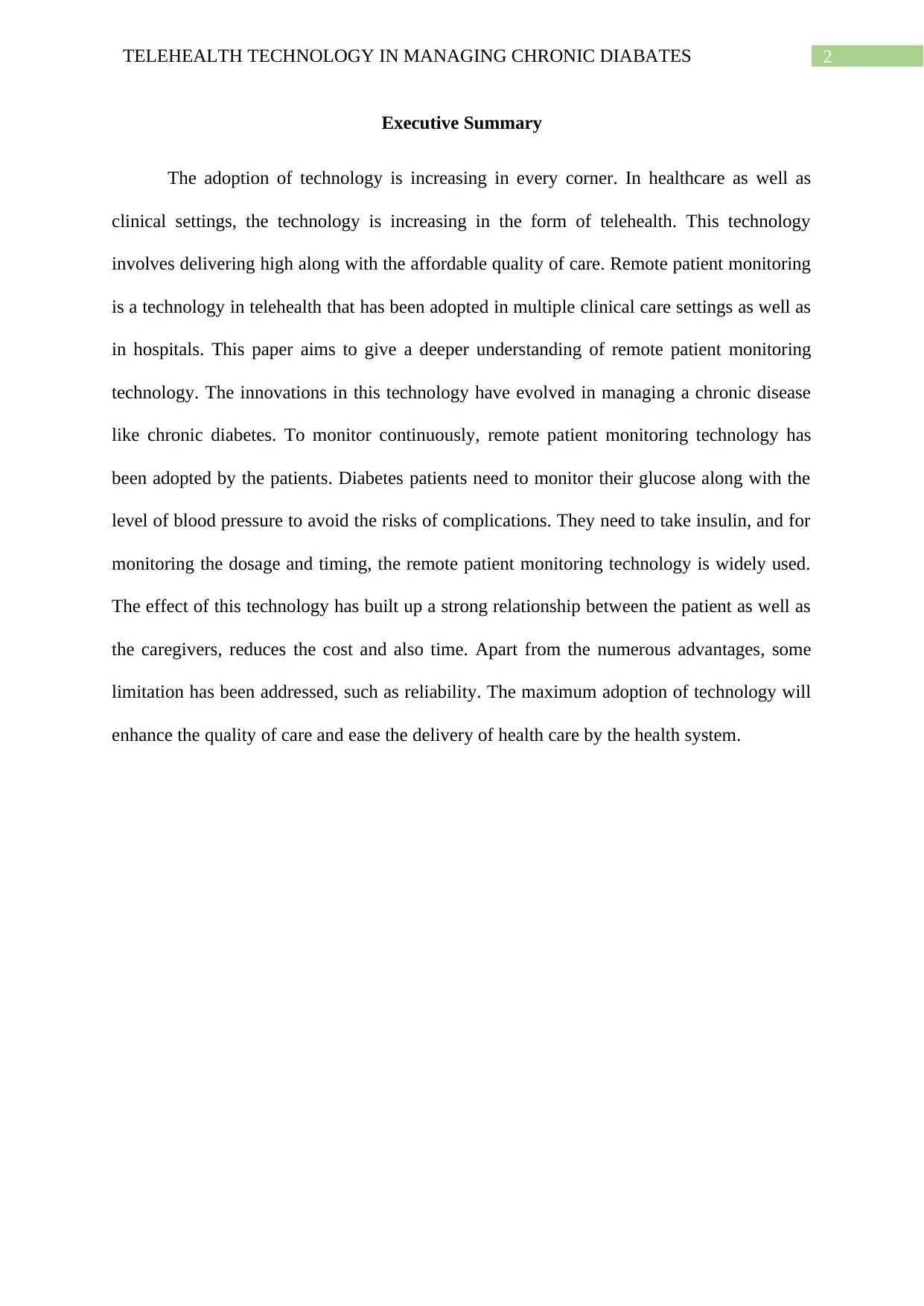
2TELEHEALTH TECHNOLOGY IN MANAGING CHRONIC DIABATES
Executive Summary
The adoption of technology is increasing in every corner. In healthcare as well as
clinical settings, the technology is increasing in the form of telehealth. This technology
involves delivering high along with the affordable quality of care. Remote patient monitoring
is a technology in telehealth that has been adopted in multiple clinical care settings as well as
in hospitals. This paper aims to give a deeper understanding of remote patient monitoring
technology. The innovations in this technology have evolved in managing a chronic disease
like chronic diabetes. To monitor continuously, remote patient monitoring technology has
been adopted by the patients. Diabetes patients need to monitor their glucose along with the
level of blood pressure to avoid the risks of complications. They need to take insulin, and for
monitoring the dosage and timing, the remote patient monitoring technology is widely used.
The effect of this technology has built up a strong relationship between the patient as well as
the caregivers, reduces the cost and also time. Apart from the numerous advantages, some
limitation has been addressed, such as reliability. The maximum adoption of technology will
enhance the quality of care and ease the delivery of health care by the health system.
Executive Summary
The adoption of technology is increasing in every corner. In healthcare as well as
clinical settings, the technology is increasing in the form of telehealth. This technology
involves delivering high along with the affordable quality of care. Remote patient monitoring
is a technology in telehealth that has been adopted in multiple clinical care settings as well as
in hospitals. This paper aims to give a deeper understanding of remote patient monitoring
technology. The innovations in this technology have evolved in managing a chronic disease
like chronic diabetes. To monitor continuously, remote patient monitoring technology has
been adopted by the patients. Diabetes patients need to monitor their glucose along with the
level of blood pressure to avoid the risks of complications. They need to take insulin, and for
monitoring the dosage and timing, the remote patient monitoring technology is widely used.
The effect of this technology has built up a strong relationship between the patient as well as
the caregivers, reduces the cost and also time. Apart from the numerous advantages, some
limitation has been addressed, such as reliability. The maximum adoption of technology will
enhance the quality of care and ease the delivery of health care by the health system.
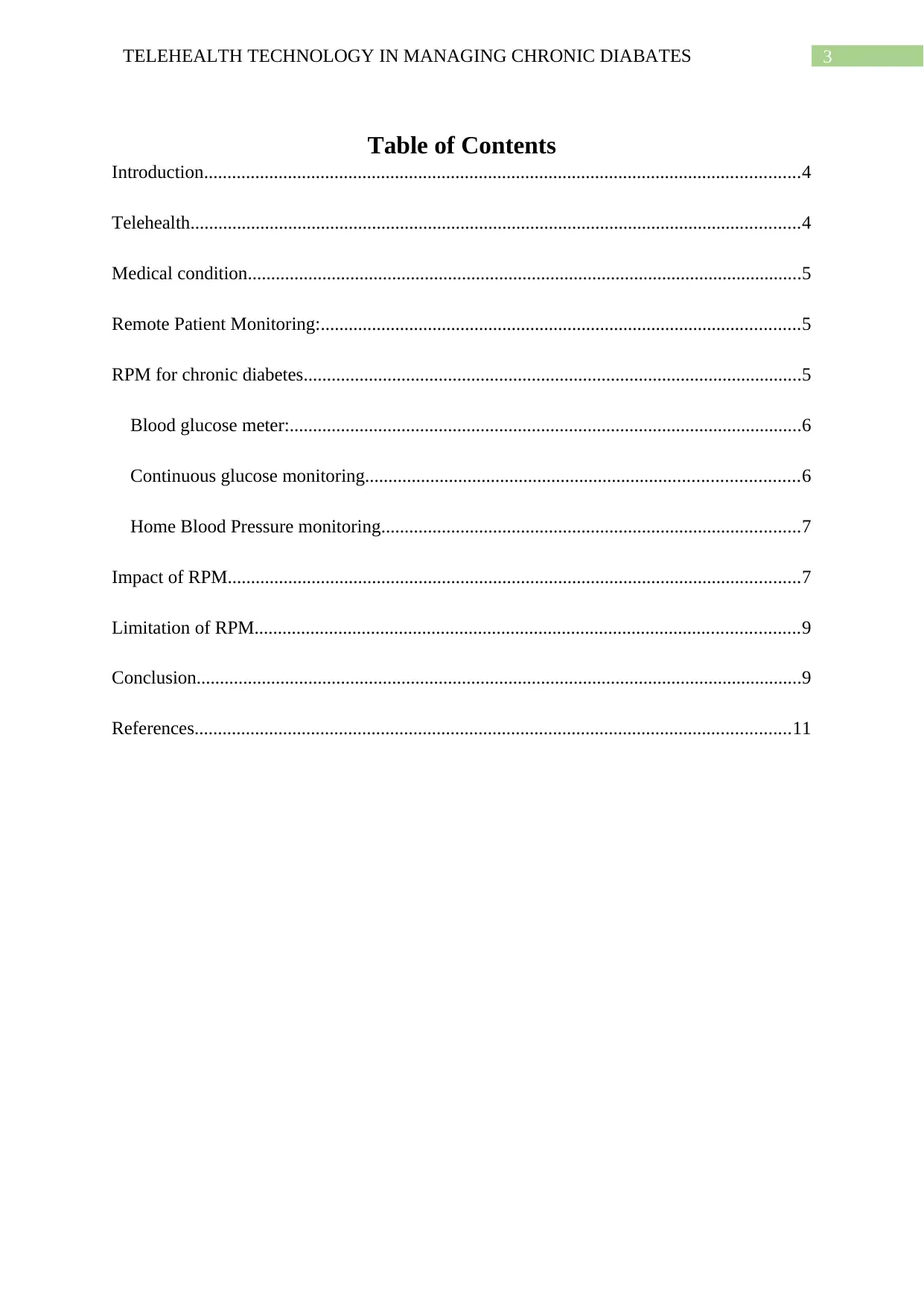
3TELEHEALTH TECHNOLOGY IN MANAGING CHRONIC DIABATES
Table of Contents
Introduction................................................................................................................................4
Telehealth...................................................................................................................................4
Medical condition.......................................................................................................................5
Remote Patient Monitoring:.......................................................................................................5
RPM for chronic diabetes...........................................................................................................5
Blood glucose meter:..............................................................................................................6
Continuous glucose monitoring.............................................................................................6
Home Blood Pressure monitoring..........................................................................................7
Impact of RPM...........................................................................................................................7
Limitation of RPM.....................................................................................................................9
Conclusion..................................................................................................................................9
References................................................................................................................................11
Table of Contents
Introduction................................................................................................................................4
Telehealth...................................................................................................................................4
Medical condition.......................................................................................................................5
Remote Patient Monitoring:.......................................................................................................5
RPM for chronic diabetes...........................................................................................................5
Blood glucose meter:..............................................................................................................6
Continuous glucose monitoring.............................................................................................6
Home Blood Pressure monitoring..........................................................................................7
Impact of RPM...........................................................................................................................7
Limitation of RPM.....................................................................................................................9
Conclusion..................................................................................................................................9
References................................................................................................................................11
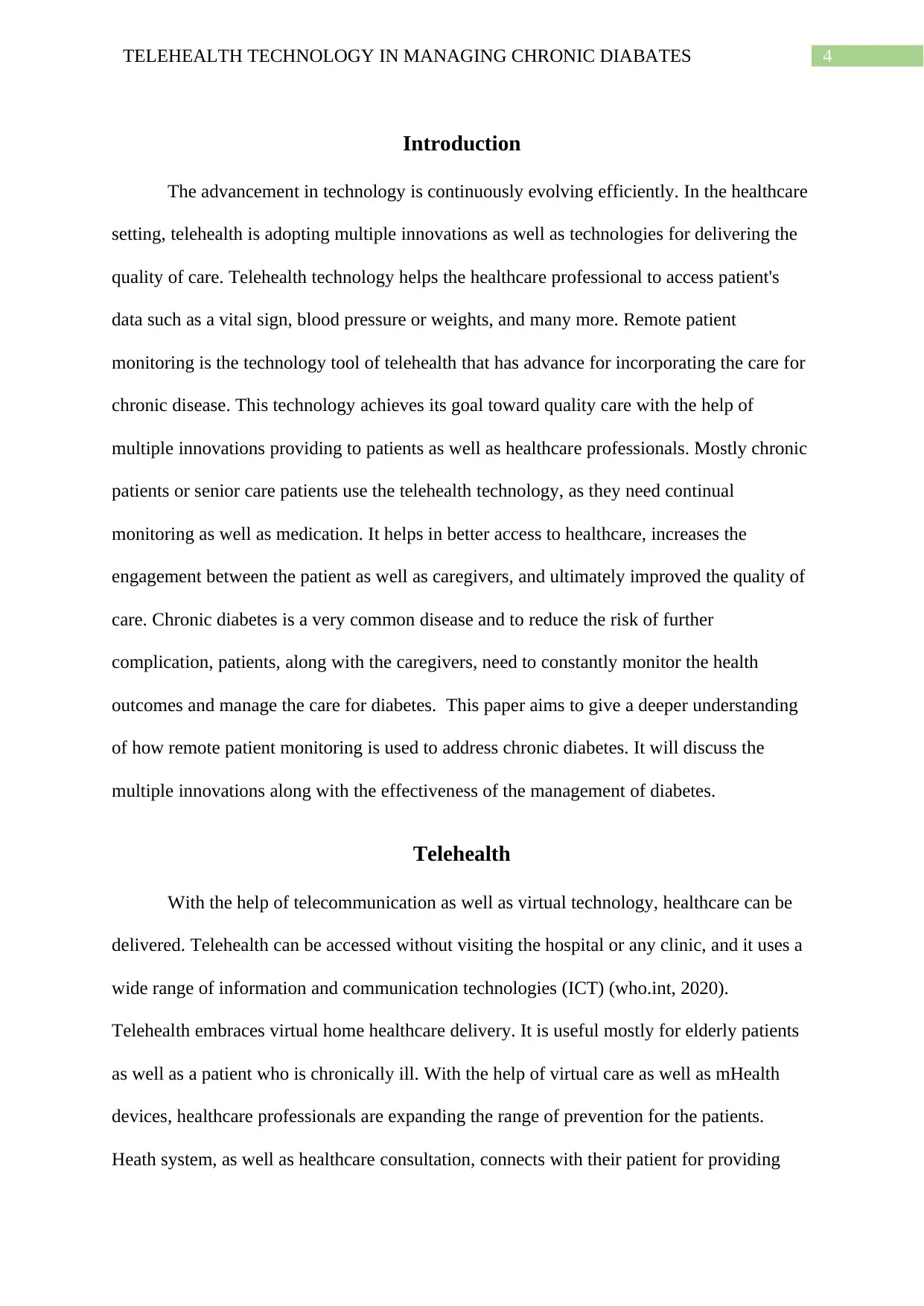
4TELEHEALTH TECHNOLOGY IN MANAGING CHRONIC DIABATES
Introduction
The advancement in technology is continuously evolving efficiently. In the healthcare
setting, telehealth is adopting multiple innovations as well as technologies for delivering the
quality of care. Telehealth technology helps the healthcare professional to access patient's
data such as a vital sign, blood pressure or weights, and many more. Remote patient
monitoring is the technology tool of telehealth that has advance for incorporating the care for
chronic disease. This technology achieves its goal toward quality care with the help of
multiple innovations providing to patients as well as healthcare professionals. Mostly chronic
patients or senior care patients use the telehealth technology, as they need continual
monitoring as well as medication. It helps in better access to healthcare, increases the
engagement between the patient as well as caregivers, and ultimately improved the quality of
care. Chronic diabetes is a very common disease and to reduce the risk of further
complication, patients, along with the caregivers, need to constantly monitor the health
outcomes and manage the care for diabetes. This paper aims to give a deeper understanding
of how remote patient monitoring is used to address chronic diabetes. It will discuss the
multiple innovations along with the effectiveness of the management of diabetes.
Telehealth
With the help of telecommunication as well as virtual technology, healthcare can be
delivered. Telehealth can be accessed without visiting the hospital or any clinic, and it uses a
wide range of information and communication technologies (ICT) (who.int, 2020).
Telehealth embraces virtual home healthcare delivery. It is useful mostly for elderly patients
as well as a patient who is chronically ill. With the help of virtual care as well as mHealth
devices, healthcare professionals are expanding the range of prevention for the patients.
Heath system, as well as healthcare consultation, connects with their patient for providing
Introduction
The advancement in technology is continuously evolving efficiently. In the healthcare
setting, telehealth is adopting multiple innovations as well as technologies for delivering the
quality of care. Telehealth technology helps the healthcare professional to access patient's
data such as a vital sign, blood pressure or weights, and many more. Remote patient
monitoring is the technology tool of telehealth that has advance for incorporating the care for
chronic disease. This technology achieves its goal toward quality care with the help of
multiple innovations providing to patients as well as healthcare professionals. Mostly chronic
patients or senior care patients use the telehealth technology, as they need continual
monitoring as well as medication. It helps in better access to healthcare, increases the
engagement between the patient as well as caregivers, and ultimately improved the quality of
care. Chronic diabetes is a very common disease and to reduce the risk of further
complication, patients, along with the caregivers, need to constantly monitor the health
outcomes and manage the care for diabetes. This paper aims to give a deeper understanding
of how remote patient monitoring is used to address chronic diabetes. It will discuss the
multiple innovations along with the effectiveness of the management of diabetes.
Telehealth
With the help of telecommunication as well as virtual technology, healthcare can be
delivered. Telehealth can be accessed without visiting the hospital or any clinic, and it uses a
wide range of information and communication technologies (ICT) (who.int, 2020).
Telehealth embraces virtual home healthcare delivery. It is useful mostly for elderly patients
as well as a patient who is chronically ill. With the help of virtual care as well as mHealth
devices, healthcare professionals are expanding the range of prevention for the patients.
Heath system, as well as healthcare consultation, connects with their patient for providing
Secure Best Marks with AI Grader
Need help grading? Try our AI Grader for instant feedback on your assignments.
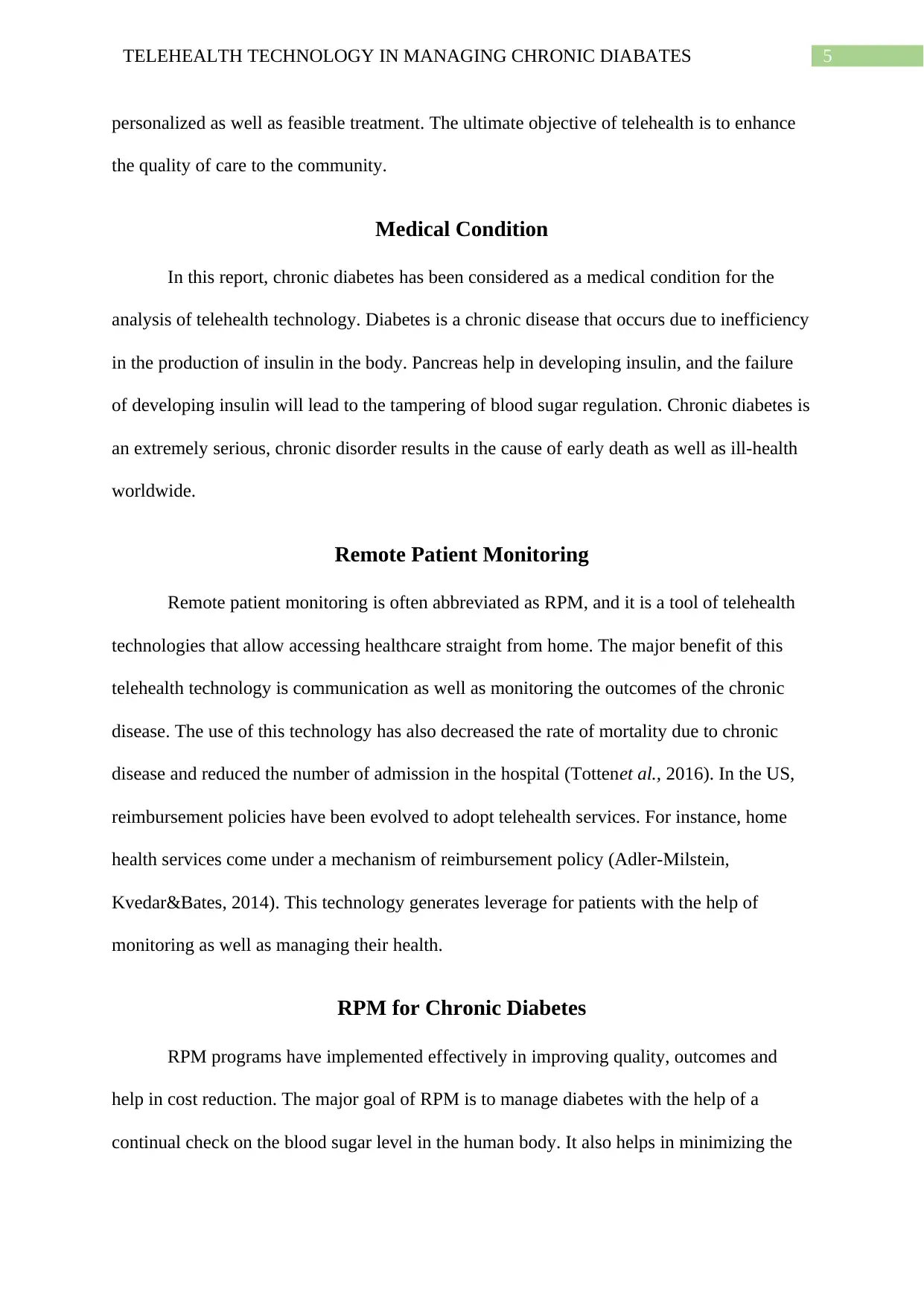
5TELEHEALTH TECHNOLOGY IN MANAGING CHRONIC DIABATES
personalized as well as feasible treatment. The ultimate objective of telehealth is to enhance
the quality of care to the community.
Medical Condition
In this report, chronic diabetes has been considered as a medical condition for the
analysis of telehealth technology. Diabetes is a chronic disease that occurs due to inefficiency
in the production of insulin in the body. Pancreas help in developing insulin, and the failure
of developing insulin will lead to the tampering of blood sugar regulation. Chronic diabetes is
an extremely serious, chronic disorder results in the cause of early death as well as ill-health
worldwide.
Remote Patient Monitoring
Remote patient monitoring is often abbreviated as RPM, and it is a tool of telehealth
technologies that allow accessing healthcare straight from home. The major benefit of this
telehealth technology is communication as well as monitoring the outcomes of the chronic
disease. The use of this technology has also decreased the rate of mortality due to chronic
disease and reduced the number of admission in the hospital (Tottenet al., 2016). In the US,
reimbursement policies have been evolved to adopt telehealth services. For instance, home
health services come under a mechanism of reimbursement policy (Adler-Milstein,
Kvedar&Bates, 2014). This technology generates leverage for patients with the help of
monitoring as well as managing their health.
RPM for Chronic Diabetes
RPM programs have implemented effectively in improving quality, outcomes and
help in cost reduction. The major goal of RPM is to manage diabetes with the help of a
continual check on the blood sugar level in the human body. It also helps in minimizing the
personalized as well as feasible treatment. The ultimate objective of telehealth is to enhance
the quality of care to the community.
Medical Condition
In this report, chronic diabetes has been considered as a medical condition for the
analysis of telehealth technology. Diabetes is a chronic disease that occurs due to inefficiency
in the production of insulin in the body. Pancreas help in developing insulin, and the failure
of developing insulin will lead to the tampering of blood sugar regulation. Chronic diabetes is
an extremely serious, chronic disorder results in the cause of early death as well as ill-health
worldwide.
Remote Patient Monitoring
Remote patient monitoring is often abbreviated as RPM, and it is a tool of telehealth
technologies that allow accessing healthcare straight from home. The major benefit of this
telehealth technology is communication as well as monitoring the outcomes of the chronic
disease. The use of this technology has also decreased the rate of mortality due to chronic
disease and reduced the number of admission in the hospital (Tottenet al., 2016). In the US,
reimbursement policies have been evolved to adopt telehealth services. For instance, home
health services come under a mechanism of reimbursement policy (Adler-Milstein,
Kvedar&Bates, 2014). This technology generates leverage for patients with the help of
monitoring as well as managing their health.
RPM for Chronic Diabetes
RPM programs have implemented effectively in improving quality, outcomes and
help in cost reduction. The major goal of RPM is to manage diabetes with the help of a
continual check on the blood sugar level in the human body. It also helps in minimizing the
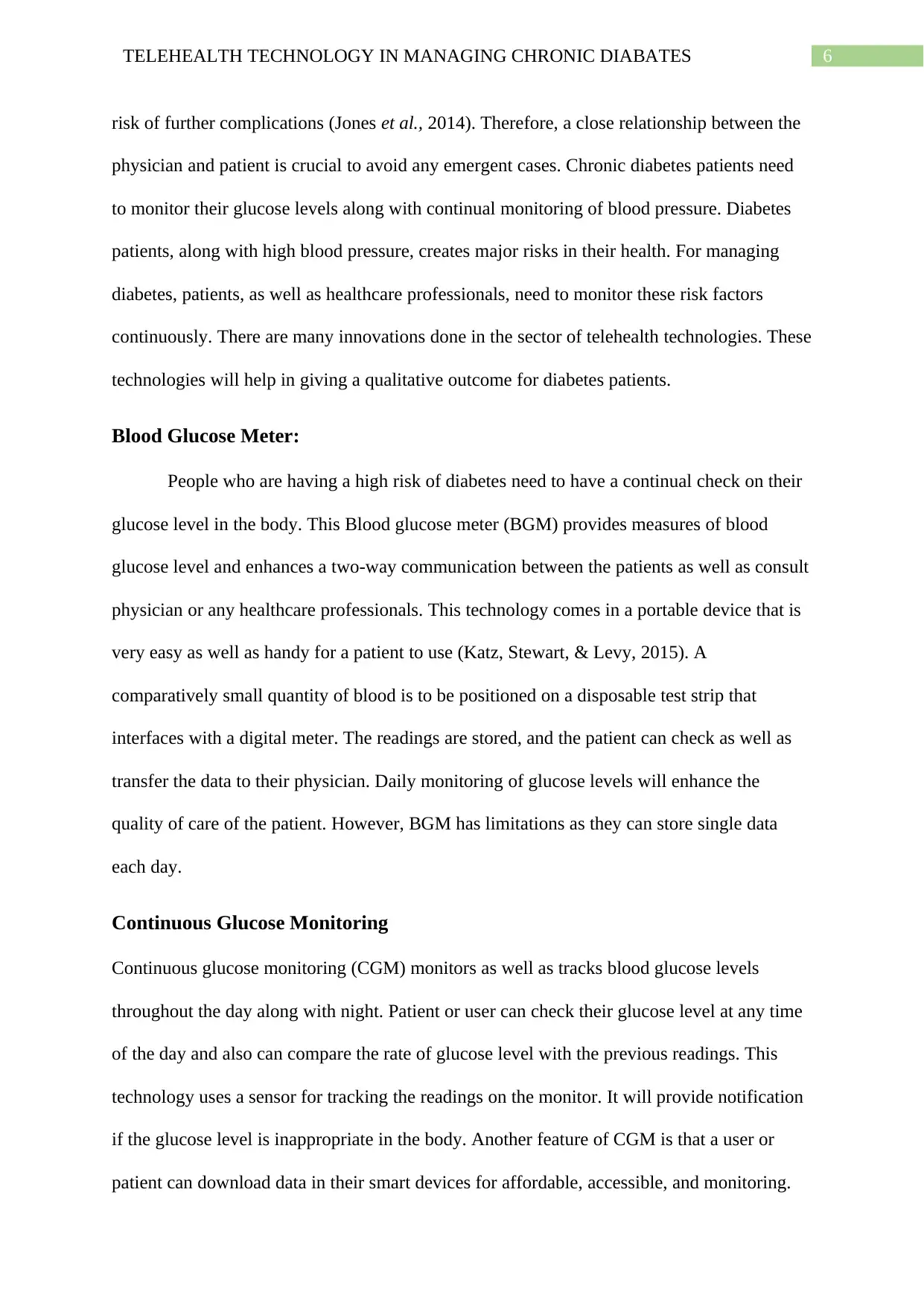
6TELEHEALTH TECHNOLOGY IN MANAGING CHRONIC DIABATES
risk of further complications (Jones et al., 2014). Therefore, a close relationship between the
physician and patient is crucial to avoid any emergent cases. Chronic diabetes patients need
to monitor their glucose levels along with continual monitoring of blood pressure. Diabetes
patients, along with high blood pressure, creates major risks in their health. For managing
diabetes, patients, as well as healthcare professionals, need to monitor these risk factors
continuously. There are many innovations done in the sector of telehealth technologies. These
technologies will help in giving a qualitative outcome for diabetes patients.
Blood Glucose Meter:
People who are having a high risk of diabetes need to have a continual check on their
glucose level in the body. This Blood glucose meter (BGM) provides measures of blood
glucose level and enhances a two-way communication between the patients as well as consult
physician or any healthcare professionals. This technology comes in a portable device that is
very easy as well as handy for a patient to use (Katz, Stewart, & Levy, 2015). A
comparatively small quantity of blood is to be positioned on a disposable test strip that
interfaces with a digital meter. The readings are stored, and the patient can check as well as
transfer the data to their physician. Daily monitoring of glucose levels will enhance the
quality of care of the patient. However, BGM has limitations as they can store single data
each day.
Continuous Glucose Monitoring
Continuous glucose monitoring (CGM) monitors as well as tracks blood glucose levels
throughout the day along with night. Patient or user can check their glucose level at any time
of the day and also can compare the rate of glucose level with the previous readings. This
technology uses a sensor for tracking the readings on the monitor. It will provide notification
if the glucose level is inappropriate in the body. Another feature of CGM is that a user or
patient can download data in their smart devices for affordable, accessible, and monitoring.
risk of further complications (Jones et al., 2014). Therefore, a close relationship between the
physician and patient is crucial to avoid any emergent cases. Chronic diabetes patients need
to monitor their glucose levels along with continual monitoring of blood pressure. Diabetes
patients, along with high blood pressure, creates major risks in their health. For managing
diabetes, patients, as well as healthcare professionals, need to monitor these risk factors
continuously. There are many innovations done in the sector of telehealth technologies. These
technologies will help in giving a qualitative outcome for diabetes patients.
Blood Glucose Meter:
People who are having a high risk of diabetes need to have a continual check on their
glucose level in the body. This Blood glucose meter (BGM) provides measures of blood
glucose level and enhances a two-way communication between the patients as well as consult
physician or any healthcare professionals. This technology comes in a portable device that is
very easy as well as handy for a patient to use (Katz, Stewart, & Levy, 2015). A
comparatively small quantity of blood is to be positioned on a disposable test strip that
interfaces with a digital meter. The readings are stored, and the patient can check as well as
transfer the data to their physician. Daily monitoring of glucose levels will enhance the
quality of care of the patient. However, BGM has limitations as they can store single data
each day.
Continuous Glucose Monitoring
Continuous glucose monitoring (CGM) monitors as well as tracks blood glucose levels
throughout the day along with night. Patient or user can check their glucose level at any time
of the day and also can compare the rate of glucose level with the previous readings. This
technology uses a sensor for tracking the readings on the monitor. It will provide notification
if the glucose level is inappropriate in the body. Another feature of CGM is that a user or
patient can download data in their smart devices for affordable, accessible, and monitoring.
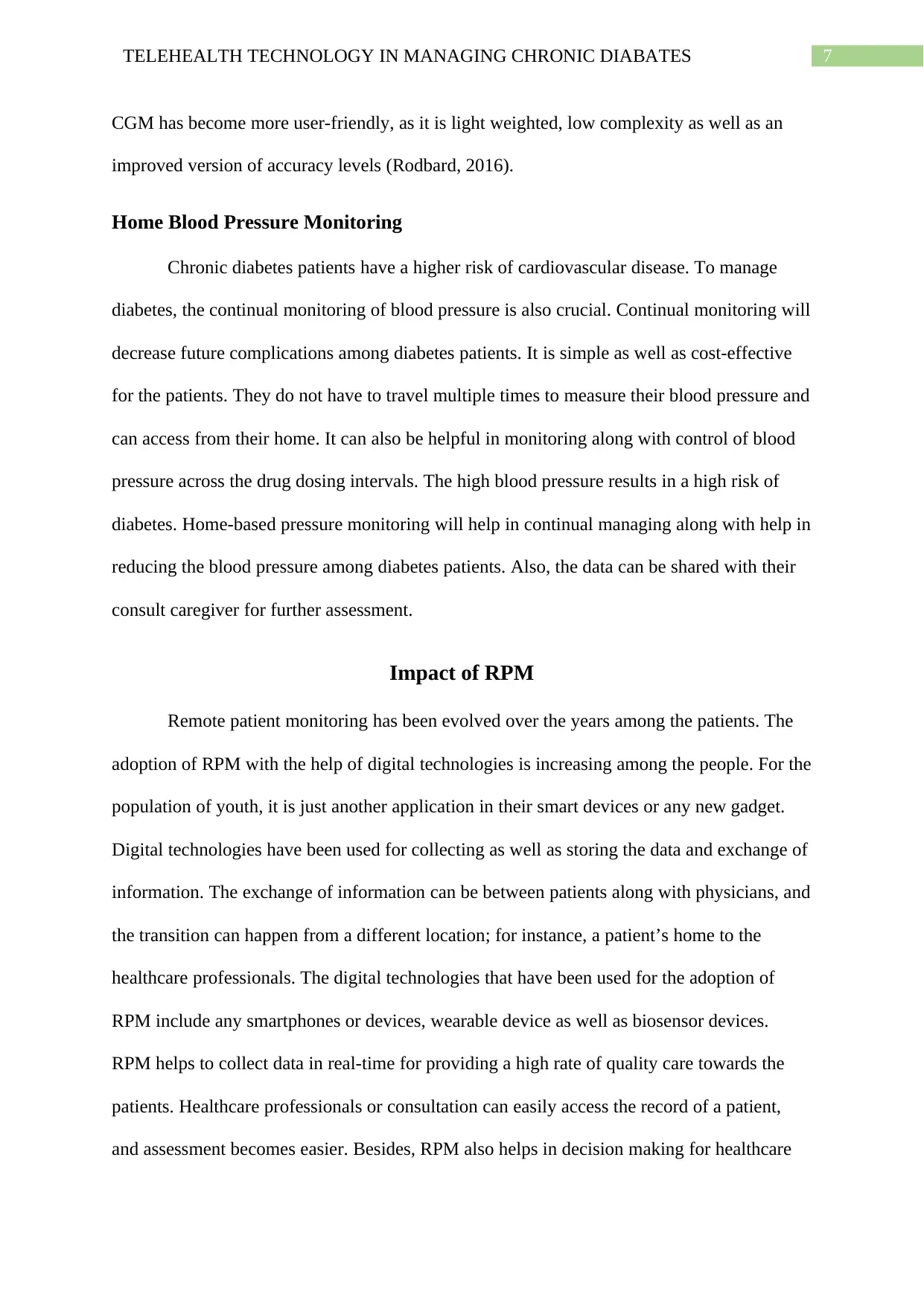
7TELEHEALTH TECHNOLOGY IN MANAGING CHRONIC DIABATES
CGM has become more user-friendly, as it is light weighted, low complexity as well as an
improved version of accuracy levels (Rodbard, 2016).
Home Blood Pressure Monitoring
Chronic diabetes patients have a higher risk of cardiovascular disease. To manage
diabetes, the continual monitoring of blood pressure is also crucial. Continual monitoring will
decrease future complications among diabetes patients. It is simple as well as cost-effective
for the patients. They do not have to travel multiple times to measure their blood pressure and
can access from their home. It can also be helpful in monitoring along with control of blood
pressure across the drug dosing intervals. The high blood pressure results in a high risk of
diabetes. Home-based pressure monitoring will help in continual managing along with help in
reducing the blood pressure among diabetes patients. Also, the data can be shared with their
consult caregiver for further assessment.
Impact of RPM
Remote patient monitoring has been evolved over the years among the patients. The
adoption of RPM with the help of digital technologies is increasing among the people. For the
population of youth, it is just another application in their smart devices or any new gadget.
Digital technologies have been used for collecting as well as storing the data and exchange of
information. The exchange of information can be between patients along with physicians, and
the transition can happen from a different location; for instance, a patient’s home to the
healthcare professionals. The digital technologies that have been used for the adoption of
RPM include any smartphones or devices, wearable device as well as biosensor devices.
RPM helps to collect data in real-time for providing a high rate of quality care towards the
patients. Healthcare professionals or consultation can easily access the record of a patient,
and assessment becomes easier. Besides, RPM also helps in decision making for healthcare
CGM has become more user-friendly, as it is light weighted, low complexity as well as an
improved version of accuracy levels (Rodbard, 2016).
Home Blood Pressure Monitoring
Chronic diabetes patients have a higher risk of cardiovascular disease. To manage
diabetes, the continual monitoring of blood pressure is also crucial. Continual monitoring will
decrease future complications among diabetes patients. It is simple as well as cost-effective
for the patients. They do not have to travel multiple times to measure their blood pressure and
can access from their home. It can also be helpful in monitoring along with control of blood
pressure across the drug dosing intervals. The high blood pressure results in a high risk of
diabetes. Home-based pressure monitoring will help in continual managing along with help in
reducing the blood pressure among diabetes patients. Also, the data can be shared with their
consult caregiver for further assessment.
Impact of RPM
Remote patient monitoring has been evolved over the years among the patients. The
adoption of RPM with the help of digital technologies is increasing among the people. For the
population of youth, it is just another application in their smart devices or any new gadget.
Digital technologies have been used for collecting as well as storing the data and exchange of
information. The exchange of information can be between patients along with physicians, and
the transition can happen from a different location; for instance, a patient’s home to the
healthcare professionals. The digital technologies that have been used for the adoption of
RPM include any smartphones or devices, wearable device as well as biosensor devices.
RPM helps to collect data in real-time for providing a high rate of quality care towards the
patients. Healthcare professionals or consultation can easily access the record of a patient,
and assessment becomes easier. Besides, RPM also helps in decision making for healthcare
Paraphrase This Document
Need a fresh take? Get an instant paraphrase of this document with our AI Paraphraser
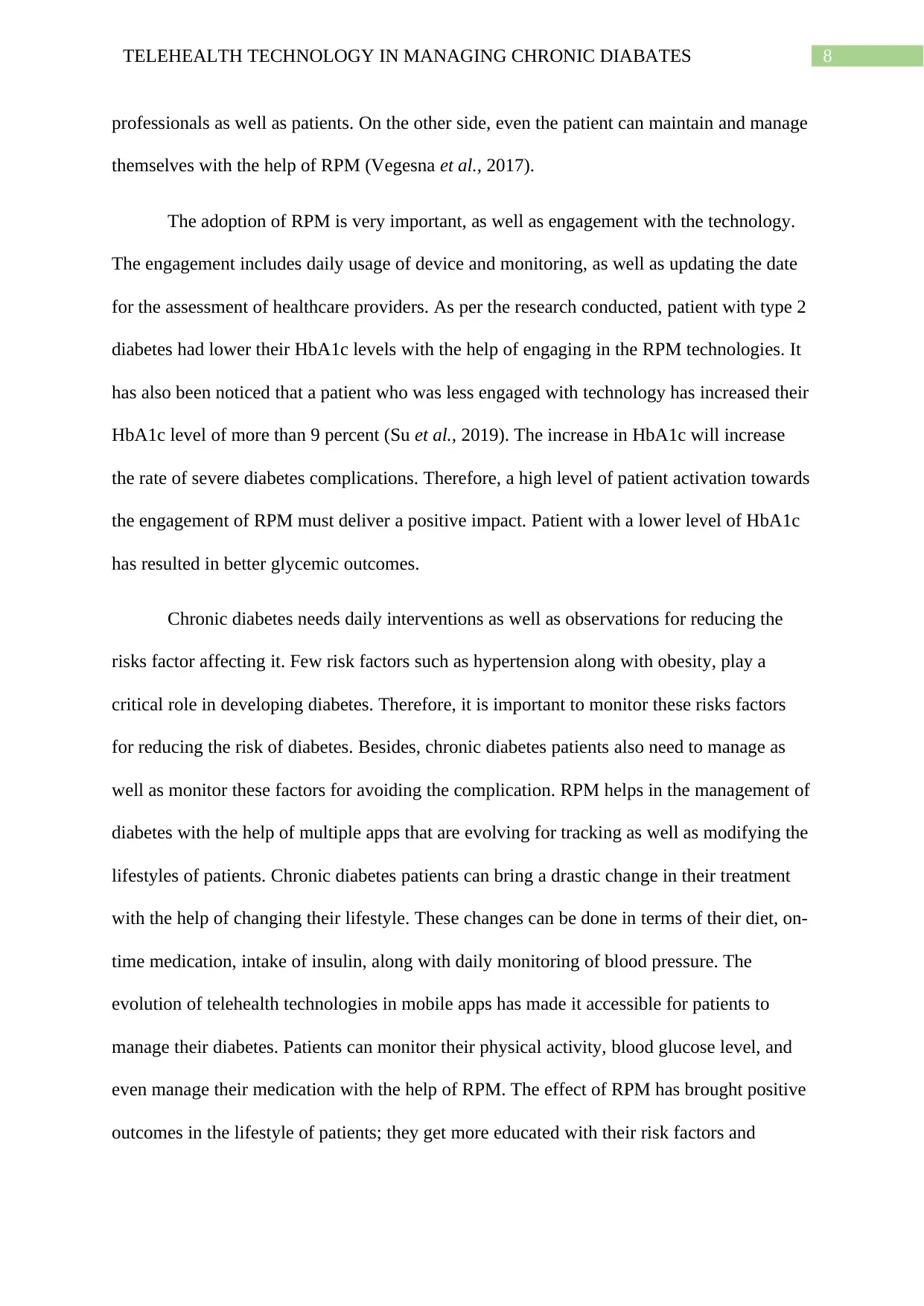
8TELEHEALTH TECHNOLOGY IN MANAGING CHRONIC DIABATES
professionals as well as patients. On the other side, even the patient can maintain and manage
themselves with the help of RPM (Vegesna et al., 2017).
The adoption of RPM is very important, as well as engagement with the technology.
The engagement includes daily usage of device and monitoring, as well as updating the date
for the assessment of healthcare providers. As per the research conducted, patient with type 2
diabetes had lower their HbA1c levels with the help of engaging in the RPM technologies. It
has also been noticed that a patient who was less engaged with technology has increased their
HbA1c level of more than 9 percent (Su et al., 2019). The increase in HbA1c will increase
the rate of severe diabetes complications. Therefore, a high level of patient activation towards
the engagement of RPM must deliver a positive impact. Patient with a lower level of HbA1c
has resulted in better glycemic outcomes.
Chronic diabetes needs daily interventions as well as observations for reducing the
risks factor affecting it. Few risk factors such as hypertension along with obesity, play a
critical role in developing diabetes. Therefore, it is important to monitor these risks factors
for reducing the risk of diabetes. Besides, chronic diabetes patients also need to manage as
well as monitor these factors for avoiding the complication. RPM helps in the management of
diabetes with the help of multiple apps that are evolving for tracking as well as modifying the
lifestyles of patients. Chronic diabetes patients can bring a drastic change in their treatment
with the help of changing their lifestyle. These changes can be done in terms of their diet, on-
time medication, intake of insulin, along with daily monitoring of blood pressure. The
evolution of telehealth technologies in mobile apps has made it accessible for patients to
manage their diabetes. Patients can monitor their physical activity, blood glucose level, and
even manage their medication with the help of RPM. The effect of RPM has brought positive
outcomes in the lifestyle of patients; they get more educated with their risk factors and
professionals as well as patients. On the other side, even the patient can maintain and manage
themselves with the help of RPM (Vegesna et al., 2017).
The adoption of RPM is very important, as well as engagement with the technology.
The engagement includes daily usage of device and monitoring, as well as updating the date
for the assessment of healthcare providers. As per the research conducted, patient with type 2
diabetes had lower their HbA1c levels with the help of engaging in the RPM technologies. It
has also been noticed that a patient who was less engaged with technology has increased their
HbA1c level of more than 9 percent (Su et al., 2019). The increase in HbA1c will increase
the rate of severe diabetes complications. Therefore, a high level of patient activation towards
the engagement of RPM must deliver a positive impact. Patient with a lower level of HbA1c
has resulted in better glycemic outcomes.
Chronic diabetes needs daily interventions as well as observations for reducing the
risks factor affecting it. Few risk factors such as hypertension along with obesity, play a
critical role in developing diabetes. Therefore, it is important to monitor these risks factors
for reducing the risk of diabetes. Besides, chronic diabetes patients also need to manage as
well as monitor these factors for avoiding the complication. RPM helps in the management of
diabetes with the help of multiple apps that are evolving for tracking as well as modifying the
lifestyles of patients. Chronic diabetes patients can bring a drastic change in their treatment
with the help of changing their lifestyle. These changes can be done in terms of their diet, on-
time medication, intake of insulin, along with daily monitoring of blood pressure. The
evolution of telehealth technologies in mobile apps has made it accessible for patients to
manage their diabetes. Patients can monitor their physical activity, blood glucose level, and
even manage their medication with the help of RPM. The effect of RPM has brought positive
outcomes in the lifestyle of patients; they get more educated with their risk factors and
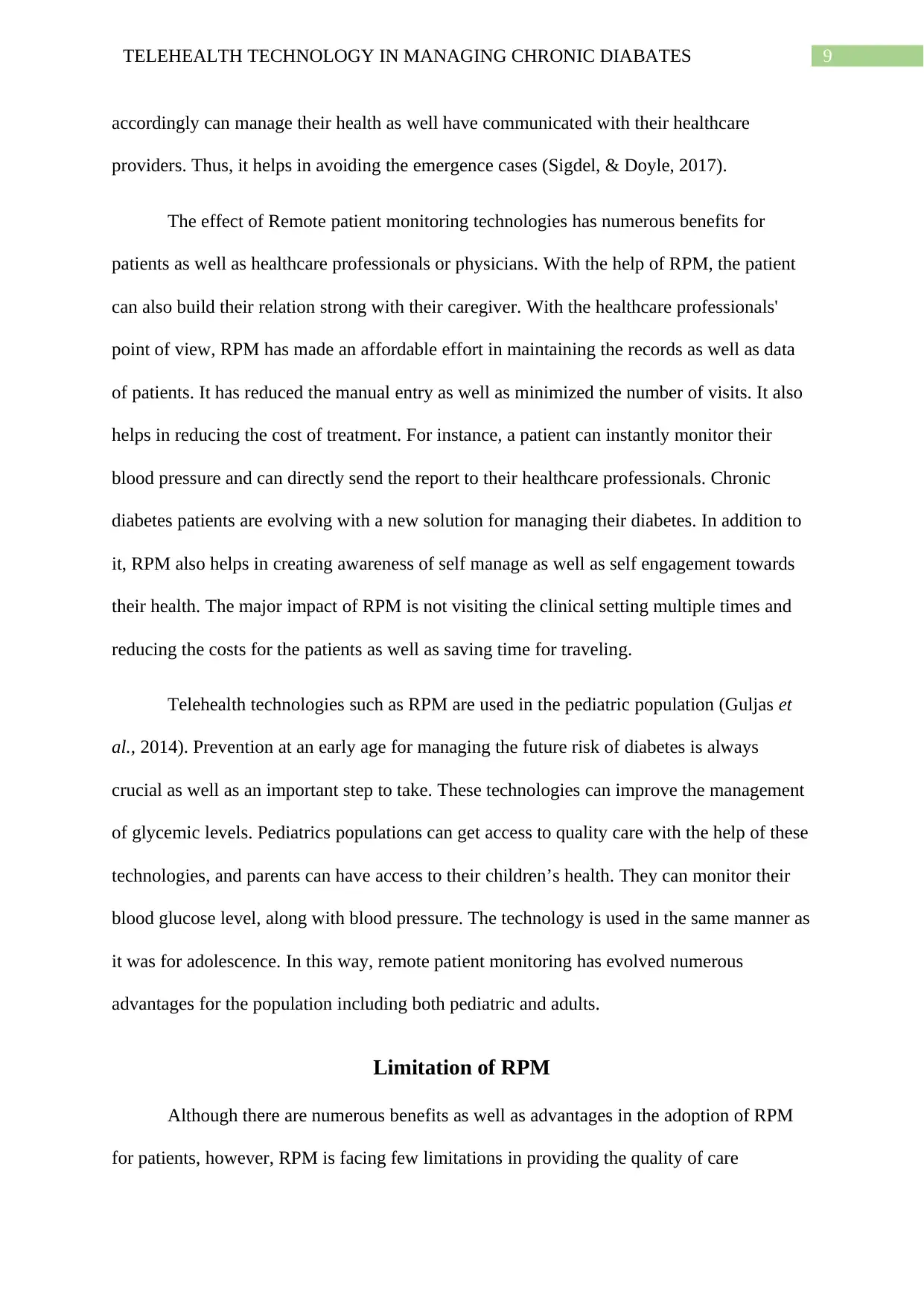
9TELEHEALTH TECHNOLOGY IN MANAGING CHRONIC DIABATES
accordingly can manage their health as well have communicated with their healthcare
providers. Thus, it helps in avoiding the emergence cases (Sigdel, & Doyle, 2017).
The effect of Remote patient monitoring technologies has numerous benefits for
patients as well as healthcare professionals or physicians. With the help of RPM, the patient
can also build their relation strong with their caregiver. With the healthcare professionals'
point of view, RPM has made an affordable effort in maintaining the records as well as data
of patients. It has reduced the manual entry as well as minimized the number of visits. It also
helps in reducing the cost of treatment. For instance, a patient can instantly monitor their
blood pressure and can directly send the report to their healthcare professionals. Chronic
diabetes patients are evolving with a new solution for managing their diabetes. In addition to
it, RPM also helps in creating awareness of self manage as well as self engagement towards
their health. The major impact of RPM is not visiting the clinical setting multiple times and
reducing the costs for the patients as well as saving time for traveling.
Telehealth technologies such as RPM are used in the pediatric population (Guljas et
al., 2014). Prevention at an early age for managing the future risk of diabetes is always
crucial as well as an important step to take. These technologies can improve the management
of glycemic levels. Pediatrics populations can get access to quality care with the help of these
technologies, and parents can have access to their children’s health. They can monitor their
blood glucose level, along with blood pressure. The technology is used in the same manner as
it was for adolescence. In this way, remote patient monitoring has evolved numerous
advantages for the population including both pediatric and adults.
Limitation of RPM
Although there are numerous benefits as well as advantages in the adoption of RPM
for patients, however, RPM is facing few limitations in providing the quality of care
accordingly can manage their health as well have communicated with their healthcare
providers. Thus, it helps in avoiding the emergence cases (Sigdel, & Doyle, 2017).
The effect of Remote patient monitoring technologies has numerous benefits for
patients as well as healthcare professionals or physicians. With the help of RPM, the patient
can also build their relation strong with their caregiver. With the healthcare professionals'
point of view, RPM has made an affordable effort in maintaining the records as well as data
of patients. It has reduced the manual entry as well as minimized the number of visits. It also
helps in reducing the cost of treatment. For instance, a patient can instantly monitor their
blood pressure and can directly send the report to their healthcare professionals. Chronic
diabetes patients are evolving with a new solution for managing their diabetes. In addition to
it, RPM also helps in creating awareness of self manage as well as self engagement towards
their health. The major impact of RPM is not visiting the clinical setting multiple times and
reducing the costs for the patients as well as saving time for traveling.
Telehealth technologies such as RPM are used in the pediatric population (Guljas et
al., 2014). Prevention at an early age for managing the future risk of diabetes is always
crucial as well as an important step to take. These technologies can improve the management
of glycemic levels. Pediatrics populations can get access to quality care with the help of these
technologies, and parents can have access to their children’s health. They can monitor their
blood glucose level, along with blood pressure. The technology is used in the same manner as
it was for adolescence. In this way, remote patient monitoring has evolved numerous
advantages for the population including both pediatric and adults.
Limitation of RPM
Although there are numerous benefits as well as advantages in the adoption of RPM
for patients, however, RPM is facing few limitations in providing the quality of care
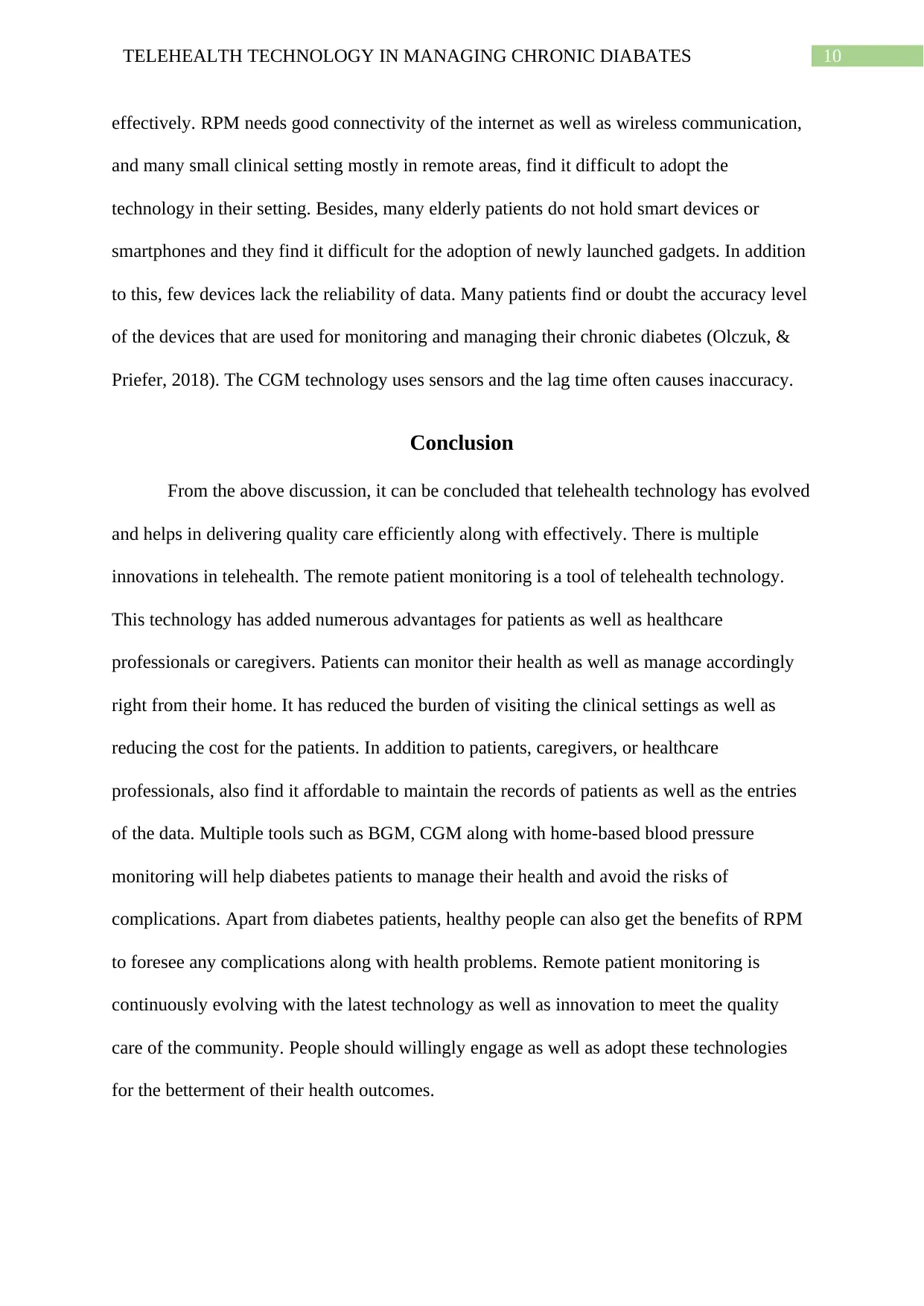
10TELEHEALTH TECHNOLOGY IN MANAGING CHRONIC DIABATES
effectively. RPM needs good connectivity of the internet as well as wireless communication,
and many small clinical setting mostly in remote areas, find it difficult to adopt the
technology in their setting. Besides, many elderly patients do not hold smart devices or
smartphones and they find it difficult for the adoption of newly launched gadgets. In addition
to this, few devices lack the reliability of data. Many patients find or doubt the accuracy level
of the devices that are used for monitoring and managing their chronic diabetes (Olczuk, &
Priefer, 2018). The CGM technology uses sensors and the lag time often causes inaccuracy.
Conclusion
From the above discussion, it can be concluded that telehealth technology has evolved
and helps in delivering quality care efficiently along with effectively. There is multiple
innovations in telehealth. The remote patient monitoring is a tool of telehealth technology.
This technology has added numerous advantages for patients as well as healthcare
professionals or caregivers. Patients can monitor their health as well as manage accordingly
right from their home. It has reduced the burden of visiting the clinical settings as well as
reducing the cost for the patients. In addition to patients, caregivers, or healthcare
professionals, also find it affordable to maintain the records of patients as well as the entries
of the data. Multiple tools such as BGM, CGM along with home-based blood pressure
monitoring will help diabetes patients to manage their health and avoid the risks of
complications. Apart from diabetes patients, healthy people can also get the benefits of RPM
to foresee any complications along with health problems. Remote patient monitoring is
continuously evolving with the latest technology as well as innovation to meet the quality
care of the community. People should willingly engage as well as adopt these technologies
for the betterment of their health outcomes.
effectively. RPM needs good connectivity of the internet as well as wireless communication,
and many small clinical setting mostly in remote areas, find it difficult to adopt the
technology in their setting. Besides, many elderly patients do not hold smart devices or
smartphones and they find it difficult for the adoption of newly launched gadgets. In addition
to this, few devices lack the reliability of data. Many patients find or doubt the accuracy level
of the devices that are used for monitoring and managing their chronic diabetes (Olczuk, &
Priefer, 2018). The CGM technology uses sensors and the lag time often causes inaccuracy.
Conclusion
From the above discussion, it can be concluded that telehealth technology has evolved
and helps in delivering quality care efficiently along with effectively. There is multiple
innovations in telehealth. The remote patient monitoring is a tool of telehealth technology.
This technology has added numerous advantages for patients as well as healthcare
professionals or caregivers. Patients can monitor their health as well as manage accordingly
right from their home. It has reduced the burden of visiting the clinical settings as well as
reducing the cost for the patients. In addition to patients, caregivers, or healthcare
professionals, also find it affordable to maintain the records of patients as well as the entries
of the data. Multiple tools such as BGM, CGM along with home-based blood pressure
monitoring will help diabetes patients to manage their health and avoid the risks of
complications. Apart from diabetes patients, healthy people can also get the benefits of RPM
to foresee any complications along with health problems. Remote patient monitoring is
continuously evolving with the latest technology as well as innovation to meet the quality
care of the community. People should willingly engage as well as adopt these technologies
for the betterment of their health outcomes.
Secure Best Marks with AI Grader
Need help grading? Try our AI Grader for instant feedback on your assignments.
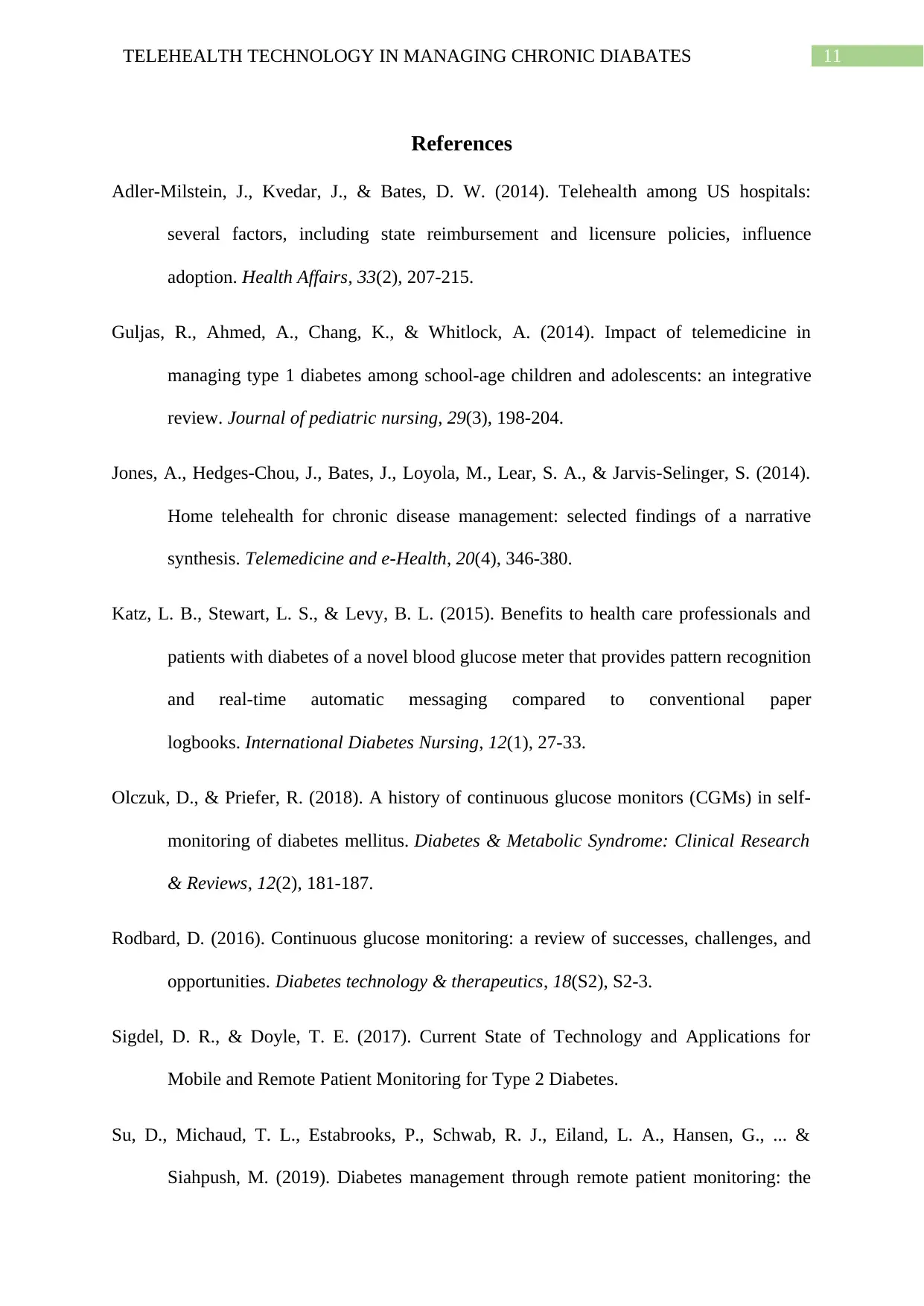
11TELEHEALTH TECHNOLOGY IN MANAGING CHRONIC DIABATES
References
Adler-Milstein, J., Kvedar, J., & Bates, D. W. (2014). Telehealth among US hospitals:
several factors, including state reimbursement and licensure policies, influence
adoption. Health Affairs, 33(2), 207-215.
Guljas, R., Ahmed, A., Chang, K., & Whitlock, A. (2014). Impact of telemedicine in
managing type 1 diabetes among school-age children and adolescents: an integrative
review. Journal of pediatric nursing, 29(3), 198-204.
Jones, A., Hedges-Chou, J., Bates, J., Loyola, M., Lear, S. A., & Jarvis-Selinger, S. (2014).
Home telehealth for chronic disease management: selected findings of a narrative
synthesis. Telemedicine and e-Health, 20(4), 346-380.
Katz, L. B., Stewart, L. S., & Levy, B. L. (2015). Benefits to health care professionals and
patients with diabetes of a novel blood glucose meter that provides pattern recognition
and real-time automatic messaging compared to conventional paper
logbooks. International Diabetes Nursing, 12(1), 27-33.
Olczuk, D., & Priefer, R. (2018). A history of continuous glucose monitors (CGMs) in self-
monitoring of diabetes mellitus. Diabetes & Metabolic Syndrome: Clinical Research
& Reviews, 12(2), 181-187.
Rodbard, D. (2016). Continuous glucose monitoring: a review of successes, challenges, and
opportunities. Diabetes technology & therapeutics, 18(S2), S2-3.
Sigdel, D. R., & Doyle, T. E. (2017). Current State of Technology and Applications for
Mobile and Remote Patient Monitoring for Type 2 Diabetes.
Su, D., Michaud, T. L., Estabrooks, P., Schwab, R. J., Eiland, L. A., Hansen, G., ... &
Siahpush, M. (2019). Diabetes management through remote patient monitoring: the
References
Adler-Milstein, J., Kvedar, J., & Bates, D. W. (2014). Telehealth among US hospitals:
several factors, including state reimbursement and licensure policies, influence
adoption. Health Affairs, 33(2), 207-215.
Guljas, R., Ahmed, A., Chang, K., & Whitlock, A. (2014). Impact of telemedicine in
managing type 1 diabetes among school-age children and adolescents: an integrative
review. Journal of pediatric nursing, 29(3), 198-204.
Jones, A., Hedges-Chou, J., Bates, J., Loyola, M., Lear, S. A., & Jarvis-Selinger, S. (2014).
Home telehealth for chronic disease management: selected findings of a narrative
synthesis. Telemedicine and e-Health, 20(4), 346-380.
Katz, L. B., Stewart, L. S., & Levy, B. L. (2015). Benefits to health care professionals and
patients with diabetes of a novel blood glucose meter that provides pattern recognition
and real-time automatic messaging compared to conventional paper
logbooks. International Diabetes Nursing, 12(1), 27-33.
Olczuk, D., & Priefer, R. (2018). A history of continuous glucose monitors (CGMs) in self-
monitoring of diabetes mellitus. Diabetes & Metabolic Syndrome: Clinical Research
& Reviews, 12(2), 181-187.
Rodbard, D. (2016). Continuous glucose monitoring: a review of successes, challenges, and
opportunities. Diabetes technology & therapeutics, 18(S2), S2-3.
Sigdel, D. R., & Doyle, T. E. (2017). Current State of Technology and Applications for
Mobile and Remote Patient Monitoring for Type 2 Diabetes.
Su, D., Michaud, T. L., Estabrooks, P., Schwab, R. J., Eiland, L. A., Hansen, G., ... &
Siahpush, M. (2019). Diabetes management through remote patient monitoring: the
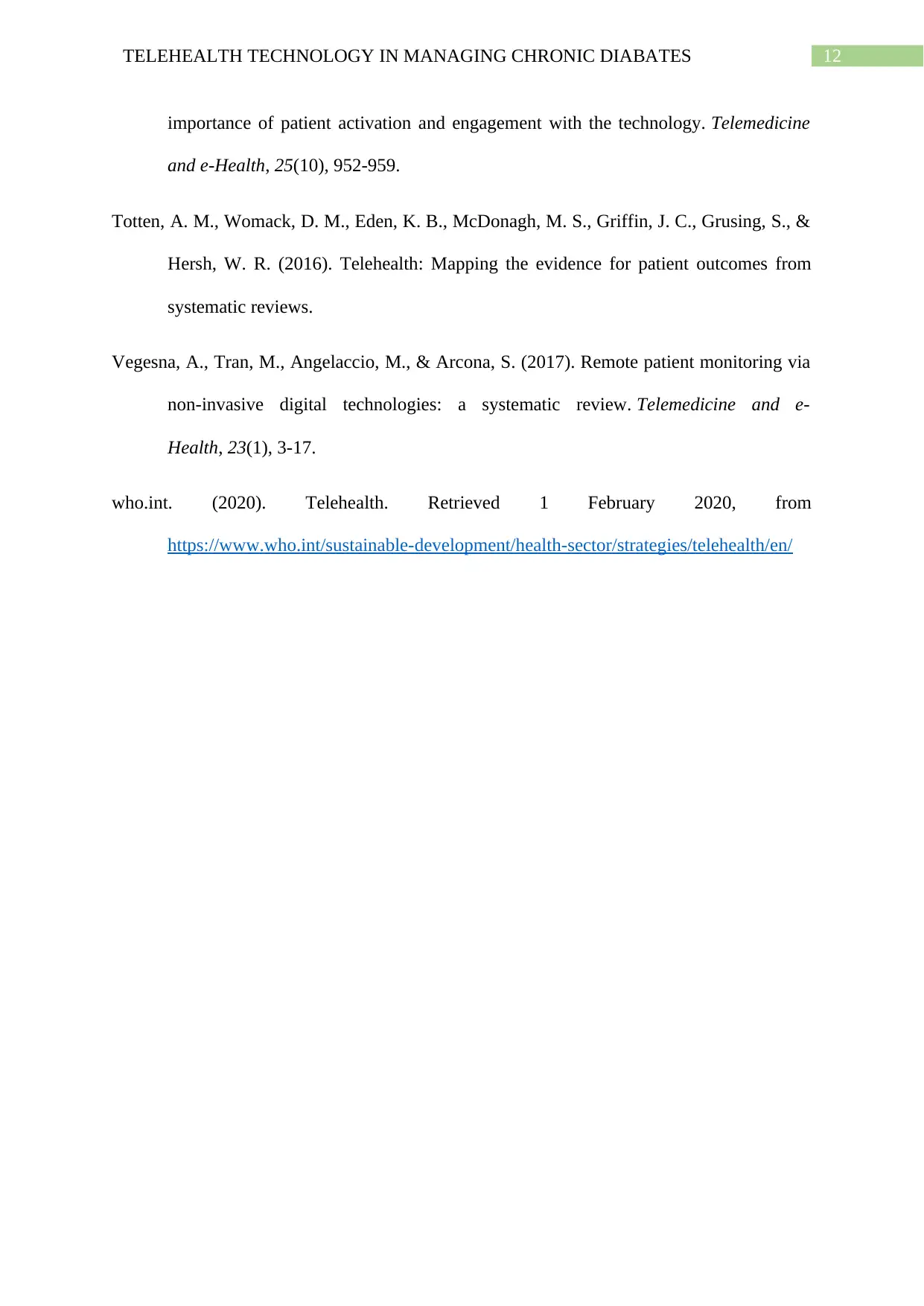
12TELEHEALTH TECHNOLOGY IN MANAGING CHRONIC DIABATES
importance of patient activation and engagement with the technology. Telemedicine
and e-Health, 25(10), 952-959.
Totten, A. M., Womack, D. M., Eden, K. B., McDonagh, M. S., Griffin, J. C., Grusing, S., &
Hersh, W. R. (2016). Telehealth: Mapping the evidence for patient outcomes from
systematic reviews.
Vegesna, A., Tran, M., Angelaccio, M., & Arcona, S. (2017). Remote patient monitoring via
non-invasive digital technologies: a systematic review. Telemedicine and e-
Health, 23(1), 3-17.
who.int. (2020). Telehealth. Retrieved 1 February 2020, from
https://www.who.int/sustainable-development/health-sector/strategies/telehealth/en/
importance of patient activation and engagement with the technology. Telemedicine
and e-Health, 25(10), 952-959.
Totten, A. M., Womack, D. M., Eden, K. B., McDonagh, M. S., Griffin, J. C., Grusing, S., &
Hersh, W. R. (2016). Telehealth: Mapping the evidence for patient outcomes from
systematic reviews.
Vegesna, A., Tran, M., Angelaccio, M., & Arcona, S. (2017). Remote patient monitoring via
non-invasive digital technologies: a systematic review. Telemedicine and e-
Health, 23(1), 3-17.
who.int. (2020). Telehealth. Retrieved 1 February 2020, from
https://www.who.int/sustainable-development/health-sector/strategies/telehealth/en/
1 out of 12
Related Documents
Your All-in-One AI-Powered Toolkit for Academic Success.
+13062052269
info@desklib.com
Available 24*7 on WhatsApp / Email
![[object Object]](/_next/static/media/star-bottom.7253800d.svg)
Unlock your academic potential
© 2024 | Zucol Services PVT LTD | All rights reserved.





